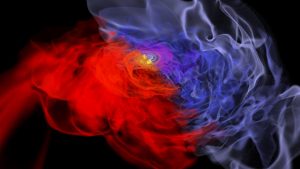**Advance booking is required here**
Dublin Institute for Advanced Studies – School of Theoretical Physics Statutory Public Lecture 2017
Friday 15th December 2017 at 6.00 p.m.
The Physics and Astrophysics of Merging Neutron-Star Binaries
By: Prof. Dr. Luciano Rezzolla (Goethe University of Frankfurt)
Location: Edmund Burke Theatre (Room 1008), Arts Building, Trinity College Dublin
Abstract: I will argue that if black holes represent one the most fascinating implications of Einstein’s theory of gravity, neutron stars in binary system are arguably its richest laboratory, where gravity blends with astrophysics and particle physics. I will discuss the rapid recent progress made in modelling these systems and show how the inspiral and merger of a binary system of neutron stars is more than a strong source of gravitational waves. Indeed, while the gravitational signal can provide tight constraints on the equation of state for matter at nuclear densities, the formation of a black-hole–torus system can explain much of the phenomenology of short gamma-ray bursts, while the ejection of matter during the merger can shed light on the chemical enrichment of the universe.
About Professor Rezzolla : Prof. Dr. Luciano Rezzolla is presently the Chair of Theoretical (Relativistic) Astrophysics and Director at the Institute for Theoretical Physics (ITP) of the Goethe University of Frankfurt, Germany. He is also Senior Fellow at the Frankfurt Institute of Advanced Studies (FIAS).

Leave a Comment
Last Updated: 23rd May 2018 by mary
15th December – School of Theoretical Physics Statutory Public Lecture 2017
**Advance booking is required here**
Dublin Institute for Advanced Studies – School of Theoretical Physics Statutory Public Lecture 2017
Friday 15th December 2017 at 6.00 p.m.
The Physics and Astrophysics of Merging Neutron-Star Binaries
By: Prof. Dr. Luciano Rezzolla (Goethe University of Frankfurt)
Location: Edmund Burke Theatre (Room 1008), Arts Building, Trinity College Dublin
Abstract: I will argue that if black holes represent one the most fascinating implications of Einstein’s theory of gravity, neutron stars in binary system are arguably its richest laboratory, where gravity blends with astrophysics and particle physics. I will discuss the rapid recent progress made in modelling these systems and show how the inspiral and merger of a binary system of neutron stars is more than a strong source of gravitational waves. Indeed, while the gravitational signal can provide tight constraints on the equation of state for matter at nuclear densities, the formation of a black-hole–torus system can explain much of the phenomenology of short gamma-ray bursts, while the ejection of matter during the merger can shed light on the chemical enrichment of the universe.
About Professor Rezzolla : Prof. Dr. Luciano Rezzolla is presently the Chair of Theoretical (Relativistic) Astrophysics and Director at the Institute for Theoretical Physics (ITP) of the Goethe University of Frankfurt, Germany. He is also Senior Fellow at the Frankfurt Institute of Advanced Studies (FIAS).
Category: News, School of Theoretical Physics News & Events
Recent Posts
DIAS Astrophotography competition goes mobile for 2024
Irish scientists are part of groundbreaking discovery with James Webb Space Telescope
Dr Pauline Gagnon (formerly of CERN) to deliver two talks at DIAS
DIAS Professor announced as next President of the European Southern Observatory’s Council
Quake Shake: New programme encourages people to get involved in monitoring earthquakes
Language switcher